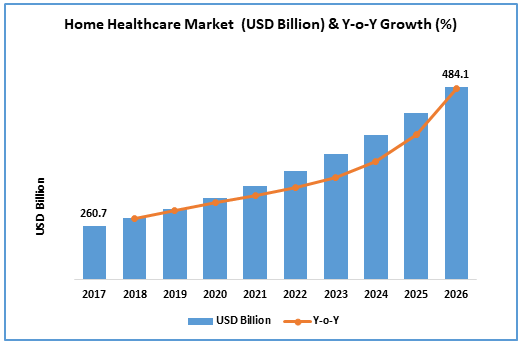60 Home Care Industry Statistics & Facts
The home care industry has grown significantly in recent years, and it continues to be an important part of the healthcare industry.
.jpg)
Home Care Industry Statistics & Facts
Home care is an essential service that helps seniors and people with disabilities live comfortably and safely in their own homes. The home care industry has grown significantly in recent years, and it continues to be an important part of the healthcare industry. Here are 60 home care industry statistics and facts to help you better understand this growing industry.

Home Care Industry Overview
- The global home healthcare market was valued at $281.8 billion in 2019. (Source: Grand View Research)
- The US home health care services market size was valued at $101.5 billion in 2019. (Source: Grand View Research)
- The US home healthcare market is projected to grow at a CAGR of 7.9% from 2020 to 2027. (Source: Grand View Research)
- The home health industry is expected to add 1.2 million new jobs between 2018 and 2028. (Source: Bureau of Labor Statistics)
- There are approximately 12,400 home health agencies operating in the US. (Source: Centers for Medicare & Medicaid Services)
- The average hourly rate for home care services in the US is $22.50. (Source: Genworth Cost of Care Survey 2020)
- The average annual cost of home care services in the US is $54,912. (Source: Genworth Cost of Care Survey 2020)
Consumers of Home Care Services
- In 2020, there were approximately 52 million Americans over the age of 65. (Source: Census Bureau)
- By 2030, the US population over the age of 65 is projected to reach 73 million. (Source: Census Bureau)
- Approximately 90% of seniors prefer to age in place in their own homes. (Source: AARP)
- Over 50% of seniors aged 75 and older live alone. (Source: AARP)
- More women (65%) than men (35%) use home care services. (Source: National Center for Health Statistics)
- The most common reason for using home care services is assistance with activities of daily living (ADLs), such as bathing, dressing, and meal preparation. (Source: National Institute on Aging)
Home Care Workers
- There are approximately 3.5 million home care workers in the US. (Source: PHI)
- The median hourly wage for home health aides was $12.15 in 2020. (Source: Bureau of Labor Statistics)
- The turnover rate for home care workers is 64.3%. (Source: Home Care Pulse)
- The average tenure for a home care worker is 1.3 years. (Source: Home Care Pulse)
- Over 90% of home care workers are women. (Source: PHI)
- Approximately 40% of home care workers are people of color. (Source: PHI)
- The top three states with the highest number of home care workers are California, New York, and Texas. (Source: PHI)

Technology in Home Care
- The use of telehealth in home care services has increased by 154% since 2018. (Source: Home Health Care News)
- Approximately 60% of home care agencies use telehealth technology. (Source: Home Health Care News)
- The use of wearable technology in home care is expected to grow at a CAGR of 13.2% from 2020 to 2027. (Source: Grand View Research)
- The most commonly used home care technology is medication management apps. (Source: Home Health Care News)
- The use of remote patient monitoring in home care is expected to increase by 13.2% from 2020 to 2027. (Source: Grand View Research)
Home Care Regulation Facts
- Home care agencies are regulated at the state level. (Source: Centers for Medicare & Medicaid Services)
- Home care agencies must meet state licensing requirements, which vary by state. (Source: Centers for Medicare & Medicaid Services)
- The Centers for Medicare & Medicaid Services (CMS) regulates home health agencies that participate in Medicare and Medicaid. (Source: Centers for Medicare & Medicaid Services)
- Home health agencies must meet CMS's Conditions of Participation to participate in Medicare and Medicaid. (Source: Centers for Medicare & Medicaid Services)
- The Joint Commission accredits home health agencies that meet certain quality standards. (Source: The Joint Commission)
Home Care Quality and Satisfaction Statistics
- Over 90% of home care clients are satisfied with the care they receive. (Source: Home Care Pulse)
- The top three factors that contribute to home care client satisfaction are caregiver competence, caregiver communication, and caregiver reliability. (Source: Home Care Pulse)
- Home care agencies that use a caregiver matching process have a client satisfaction rate that is 9% higher than agencies that do not use a matching process. (Source: Home Care Pulse)
- The average caregiver rating on online home care review sites is 4.7 out of 5 stars. (Source: Caring.com)
- The top three factors that contribute to home care worker job satisfaction are client relationships, scheduling flexibility, and pay. (Source: Home Care Pulse)

Home Care Challenges
- The shortage of home care workers is a significant challenge for the industry. (Source: PHI)
- The number of older adults in need of care is expected to double by 2040, while the number of available caregivers is projected to increase by only 1%. (Source: PHI)
- The COVID-19 pandemic has had a significant impact on the home care industry, with many agencies experiencing staffing shortages and increased costs. (Source: Home Health Care News)
- Home care agencies must navigate complex regulatory requirements and reimbursement structures. (Source: Home Health Care News)
- Home care agencies are facing increasing competition from technology-based home care solutions. (Source: Home Health Care News)
Home Care Insurance and Payment
- Medicare covers home health care services for eligible beneficiaries. (Source: Centers for Medicare & Medicaid Services)
- Medicaid covers home care services for eligible beneficiaries, but coverage varies by state. (Source: Centers for Medicare & Medicaid Services)
- Private insurance may cover home care services, but coverage varies by policy. (Source: Genworth Cost of Care Survey 2020)
- Approximately 80% of home care services are paid for by private pay or long-term care insurance. (Source: National Association for Home Care & Hospice)
- The average Medicaid reimbursement rate for home health services is $121 per visit. (Source: Medicare Payment Advisory Commission)
- The average Medicare reimbursement rate for home health services is $150.12 per visit. (Source: Medicare Payment Advisory Commission)
- The average Medicaid reimbursement rate for personal care services is $20.33 per hour. (Source: CMS)
Home Care and Hospice
- Hospice is a type of home care that provides end-of-life care to terminally ill patients. (Source: National Hospice and Palliative Care Organization)
- Approximately 1.5 million Americans receive hospice care each year. (Source: National Hospice and Palliative Care Organization)
- The most common diagnosis among hospice patients is cancer. (Source: National Hospice and Palliative Care Organization)
- Over 90% of hospice care is paid for by Medicare. (Source: National Hospice and Palliative Care Organization)
- The average length of hospice care is 24 days. (Source: National Hospice and Palliative Care Organization)

Home Care and Dementia
- Approximately 5.8 million Americans are living with Alzheimer's disease. (Source: Alzheimer's Association)
- By 2050, the number of Americans living with Alzheimer's disease is expected to reach 14 million. (Source: Alzheimer's Association)
- Approximately 70% of people with Alzheimer's disease live at home. (Source: Alzheimer's Association)
- The cost of care for a person with Alzheimer's disease is 3 times higher than the cost of care for a person without dementia. (Source: Alzheimer's Association)
- Home care agencies that specialize in dementia care have a client satisfaction rate that is 6% higher than agencies that do not specialize in dementia care. (Source: Home Care Pulse)
Home Care and Mental Health
- Approximately 20% of adults over the age of 55 have a mental health disorder. (Source: National Council on Aging)
- Depression is the most common mental health disorder among older adults. (Source: National Council on Aging)
- Home care agencies that provide mental health services have a client satisfaction rate that is 8% higher than agencies that do not provide mental health services. (Source: Home Care Pulse)
Facts and Figures: Home Care Industry Statistics
To gain a deeper understanding of the home care industry, it's important to examine some key home care industry statistics. These statistics shed light on the number of home care providers, employment in the home care sector, and consumer perspectives on home care services.
- Number of Home Care Providers: The home care industry is comprised of various organizations and agencies that provide essential care and support to individuals in their own homes. As of recent data, there are approximately 408,868 home care providers in the United States alone. These providers range from small local businesses to larger national franchises, offering a wide array of services to cater to the diverse needs of their clients.
- Employment in the Home Care Sector: The home care industry plays a crucial role in providing employment opportunities for individuals who are passionate about caregiving. The demand for home care services has led to substantial job growth within the sector. In fact, the home care industry is one of the fastest-growing industries in terms of employment. As of recent statistics, it is estimated that the home care sector employs over 2 million individuals in the United States, including home health aides, personal care aides, and other caregiving professionals.

Technological Advancements in Home Care
- Telehealth and Remote Monitoring: Telehealth technologies enable healthcare professionals to provide virtual consultations, monitor patients remotely, and manage chronic conditions from the comfort of their own homes. This not only enhances accessibility to care, especially for those in remote areas, but also reduces the need for frequent in-person visits.
- Smart Home Devices: Smart home devices, such as voice-activated assistants and sensor-based monitoring systems, are transforming the way individuals receive care at home. These devices can assist with medication reminders, fall detection, and emergency response, promoting independence and safety for individuals in need of care.
- Electronic Health Records (EHR): EHR systems streamline the documentation and sharing of patient information among healthcare providers, ensuring coordinated and comprehensive care. This technology enables efficient communication and collaboration between care teams, leading to improved outcomes for patients.
The Future of the Home Care Industry
- Expansion and Growth: The home care industry is projected to experience significant growth in the coming years, driven by an aging population and a preference for receiving care in the comfort of one's home. This growth presents opportunities for home care providers to expand their services and reach a larger clientele.
- Integration of Care: The future of home care involves greater integration with other healthcare sectors, such as hospitals and primary care providers. Collaborative care models that promote seamless transitions between different care settings will become increasingly important to ensure continuity of care and improve patient outcomes.
- Focus on Personalized Care: With advancements in technology and the availability of comprehensive patient data, the home care industry is moving towards a more personalized approach to care. Tailoring care plans to individual needs and preferences will be a key focus, ensuring that patients receive personalized, patient-centered care.
FAQs
What is home care?
Home care is a type of healthcare service that provides assistance to seniors and people with disabilities in their own homes. Home care services can include help with activities of daily living (ADLs), medication management, wound care, and more.
How much does home care cost?
The cost of home care services varies depending on several factors, including the level of care needed, the location, and the agency providing the services. According to the Genworth Cost of Care Survey 2020, the average hourly rate for home care services in the US is $22.50, and the average annual cost is $54,912.
Who pays for home care?
Home care services may be paid for by private pay, long-term care insurance, Medicare, or Medicaid. Private pay and long-term care insurance coverages vary depending on policy terms. Medicare covers home health services for eligible beneficiaries if certain criteria are met. Medicaid covers home care services for eligible beneficiaries based on state-specific requirements.
What qualifications do home care workers need?
The qualifications required for home care workers vary depending on state regulations and agency policies. In general, home health aides must complete a training program and pass a competency evaluation before providing direct patient care. Some states also require certification or licensure for certain types of home health workers.
How can I find a reputable home care agency?
To find a reputable home care agency in your area, you can start by asking for recommendations from friends or family members who have used such services in the past. You can also search online directories or use resources provided by organizations such as the National Association for Home Care & Hospice or Aging Life Care Association. It's important to research potential agencies thoroughly and ask questions about their qualifications, experience, and quality measures before making a decision.
Summary
In conclusion, the home care industry is a growing and important part of the healthcare industry. Home care services provide essential support to seniors and people with disabilities, allowing them to live comfortably and safely in their own homes. The industry faces many challenges, including a shortage of workers and complex regulatory requirements, but it continues to evolve and adapt to meet the needs of its clients.


































































































